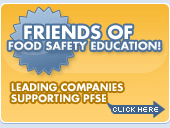|
Mat Release - Tips For Safely Cooking Up Family Meals |

|
|
(NAPS) - Whether you're cooking for a party or simply a family dinner, it's important to keep food safety on the menu throughout the year.
That's the advice from experts who say consistency in maintaining clean surfaces and handling food safely can prevent the growth and spread of germs and keep your family safe.
To help, the Alliance for Consumer Education and the Partnership for Food Safety Education offers these tips for safely preparing food:
- Wash Your Hands - Washing seems like an obvious step but is often overlooked. Wash hands thoroughly with warm water and soap. Try singing the "Happy Birthday" song through two times and rinse well for effective hand washing.
- Clean and Disinfect, Before and After - Clean and disinfect kitchen surfaces and utensils. Wash your cutting boards, dishes, utensils and counter tops with hot soapy water after preparing each food item and before you go on to the next food. Not all cleaning products disinfect, but those with the word "disinfect" or "disinfectant" on the label have been tested and shown to kill household germs. Read the product label carefully to make sure that you are using a product that does disinfect and always follow usage directions.
- Use a Food Thermometer - Use it whenever you cook hamburger and other ground meats, poultry, roasts and casseroles. The only way to know that food is cooked to a safe internal temperature is to use a thermometer. Download a safe cooking temperatures table from www.fightbac.org.
- Chill - Make a habit of refrigerating leftover foods right away to prevent the growth of harmful bacteria. Keeping a constant refrigerator temperature of 40° F or below as measured by an appliance thermometer is one of the most effective ways to reduce the risk of food-borne illness.
For more information on keeping you and your family healthy, please visit www.StopGerms.org and www.fightbac.org.
Did you know?
The Alliance for Consumer Education and the Partnership for Food Safety Education says the only way to know that meats and casseroles are cooked to a safe internal temperature is to use a food thermometer. Download a safe cooking temperatures table from www.fightbac.org. |
Whether you're cooking for a party or simply a family dinner, it's important to keep food safety on the menu throughout the year. ///Tips For Safely Cooking Up Family Meals |




















